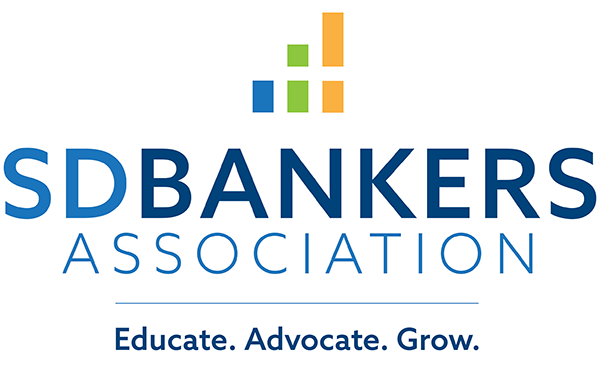- Education & Events
- Advocacy
- Products & Services
- Membership
- Resources
- SDBANKER Magazine
- SDBA eNews
- SDBA eNews Archives
- Legislative Update/Bill Watch
- South Dakota Bank Directory
- Women in Banking
- Scenes of South Dakota Calendar*
- Holiday Signs
- Regulatory Report
- South Dakota Banking Code
- Record Retention Manual
- Advertising & Sponsorship Guide
- COVID-19 Resources
- Mental Health and Crisis Prevention
- About
|
Banking groups call for changes to SEC cyber incident reporting proposal
On Monday, American Bankers Association and a coalition of financial services groups called for extensive changes to a proposal by the Securities and Exchange Commission that would create new requirements for public companies regarding the disclosure of cybersecurity incidents. Among other things, the SEC would amend Form 8-K to require that registrants “disclose information about a material cybersecurity incident within four business days after the registrant determines that it has experienced a material cybersecurity incident.” Among other things, the groups called for changes to the timing of disclosure to “four business days after the registrant has reasonably determined that the cybersecurity incident is no longer ongoing, and that public disclosure of the incident will not seriously jeopardize the security of the registrant,” emphasizing that the current proposal’s requirements lack “sufficient regard for the security risks and harms that such disclosures may pose in certain circumstances.” They also urged the SEC to not require registrants to disclose information about remediation activities, including changes to cybersecurity policies and procedures; called for clarity around several definitions and other aspects of the proposal; and advocated for less prescriptive requirements. The groups also opposed a proposed requirement for registrants to disclose the cybersecurity expertise of members of the board, noting that it “will have the effect of suggesting that boards without directors with such specific expertise are somehow deficient.” Read the letter. Survey: Banking outpaces other industries in preparing to combat fraud and corruptionThe banking sector is among the most prepared industries to combat fraud, corruption and illicit activity, according to a recent report. According to the results of a recent survey of more than 1,330 senior risk-strategy decision-makers across multiple industries, 84% of respondents in the banking sector reported they had conducted an internal investigation in the last three years—more than any other sector surveyed. In addition, 89% of respondents in the banking sector reported their organization had been significantly affected by serious misconduct—the second highest behind travel and tourism. The report, conducted by risk and compliance technology firm Kroll, noted that the costs associated with investigating fraud and illicit activity have increased, particularly for organizations with revenue of more than $15 billion. The survey also indicated that risk professionals believe that some investigative services firms fail to deliver value, suggesting that many external providers may not employ the most up-to-date technology to find relevant information in massive volumes of structured and unstructured data. Almost all organizations (98%) that had conducted an internal investigation recruited the help of external firms to assist, with computer forensics/eDiscovery firms used most frequently (55%), followed by investigations firms (47%). Despite advancements in technology and data analytics, nearly four in five (79%) respondents said the cost of investigations had increased in the past three years.
Fed report: Banking system remains strong, assessing of fintech risk ramps upThe banking system remained strong overall, with robust capital and liquidity and improved asset quality in the second half of 2021, according to the Federal Reserve’s latest supervision and regulation report released today. The Fed said that risk monitoring will continue for potential effects of the pandemic and new geopolitical risks, including Russia’s invasion of Ukraine. The banking industry ended 2021 with strong capital positions, the report noted. Since the pandemic began, the industry has added nearly $230 billion in additional common equity tier 1 capital, providing support for lending and a buffer against losses. Strong deposit growth has spurred the increase in liquid assets and allowed banks to reduce their reliance on more volatile forms of funding. Bank profitability declined in the last three quarters of 2021 but remains sound and comparable with pre-pandemic levels, the report said. The decline was due to reduced benefits from negative provision expense and lower trading income at large banks. The Fed said that it will continue to focus on capital and liquidity management, as well as cybersecurity. The Fed is also reviewing the risks created by the increasing use of technology by financial institutions and is enhancing its supervisory approaches to respond to these risks. “Banks are expected to ensure appropriate controls are established to support new fintech products and services,” the Fed wrote. “As banks engage in these activities, they should develop and implement risk-management practices and controls at a pace that aligns with their growth.” The report noted that while all sized of banks have embraced fintech, the approaches to adopting it vary across banking segments. The Fed has established a System Fintech Supervisory Program to assess the range of fintech risk. The program is developing a “coordinated supervisory strategy” that will be tailored to a bank’s size and complexity. The report also noted that U.S. banks have heightened their cyber defenses in response to geopolitical tensions. Elder Justice: Who are the Criminals Behind the Scams? How do They do It?The ABA Foundation, Federal Bureau of Investigation and other industry partners will host the second of a three-part webinar series on protecting older Americans from scams and fraud on May 16 at 11 a.m. CDT. The webinar will provide insights from government experts about recent fraud trends, as well as information on the criminals who are employing these types of scams to defraud seniors. The ABA Foundation offers resources for banks to help educate consumers on elder fraud and other scams through its Safe Banking for Seniors program. Register for the webinar. 5 Best Predictors of Employee Turnover and What Leaders Should Do About Themby Peter Cohan, Inc. Hiring and motivating your employees is more important and challenging than ever. With 47 million people quitting their jobs in 2021, a 3.6 percent unemployment rate in April 2022, and 11.5 million jobs open in March, it is imperative that business leaders attract and keep top talent. If I were trying to help business leaders with this problem, I would study the sources of employee turnover and try to uncover how companies with the highest employee retention rates manage their employees. Research Into Key Drivers of the Great Resignation Attrition rates vary by industry. Blue collar industries in apparel retail, fast food, and specialty retail had the highest attrition rates. In white collar fields such as management consulting and enterprise software, turnover was high -- but less so in medical device makers and health insurers, according to SMR. What I found most interesting is that some of the most innovative companies had the highest rates of employee turnover. Innovative companies -- "such as SpaceX, Tesla, Nvidia, and Netflix -- suffer higher attrition rates ... than companies with a reputation for a healthy culture, such as Southwest Airlines, Johnson & Johnson, Enterprise Rent-a-Car, and LinkedIn," according to SMR. To investigate what was causing all the resignations, the co-authors analyzed over 1.4 million Glassdoor reviews of the companies they studied. They counted "how frequently employees mentioned 172 topics and how positively they talked about each topic." From there, they pinpointed which "topics best predicted a company's industry-adjusted attrition rate," according to SMR. 5 Biggest Predictors of Employee Turnover Here are the five biggest predictors of employee turnover during the Great Resignation, according to SMR, and how much more important they are than compensation:
4 Short-Term Actions to Boost Retention Here are the four actions ranked according to how well each action boosts a company's relative retention rate compared with compensation.
On the basis of my experience in management consulting, I think the most innovative companies will keep attracting top talent despite their higher turnover. For more sedate companies, doing these four things will help boost worker retention.
Save the Date: Ag Credit Conference, July 20-21 - Pierre, SDMark your calendars for the SDBA's 2022 Agricultural Credit Conference, July 20-21, in Pierre, S.D., at the Ramkota Hotel & Conference Center! A full agenda and registration information will be coming out very soon, so be on the lookout! Keeping Your SDBA Member Profile CurrentOne of the best ways to stay current with the SDBA is to make sure your member profile is current and accurate. You can easily review this information by clicking here and logging into your profile. Forgot your password and/or username? No problem--you can request a password reset from the SDBA so you can quickly access your account. Key items to check up on are: Title, Job Function, Bank, and Contact Information (phone, address and email.) Additionally, you can subscribe to correspondence with the SDBA that you may not already be subscribed to. What about Protective Alerts, Legislative Updates, and Education Updates? If you're not already receiving these and would like to start, please email [email protected] to request being added to the distribution lists. The best way for you to engage with the SDBA, and therefore advocate for our industry, starts with a current member profile!
Register Today for the NDBA/SDBA Annual ConventionJoin North and South Dakota bankers, June 14-15, for an incredible convention in Bismarck, as the community celebrates 150 years. We will be reminded in all of the best ways why we do what we do, why we do it together, and why we are grateful to make a difference in our hometowns throughout the Dakotas. A dynamic convention program awaits with many top-of-mind topics: leadership, employee retention, the economy, cryptocurrency and cybersecurity. The challenges of today create opportunities for tomorrow. As generations before us blazed trails, let’s gather together and continue to shape the future. Onward! The full schedule and registration information can be found here. Compliance Alliance offers a comprehensive suite of compliance management solutions. To learn how to put them to work for your bank, call (888) 353-3933 or email [email protected] and ask for our Membership Team. For timely compliance updates, subscribe to Bankers Alliance’s email newsletters. SDBA eNews Archive Advertising Opportunity Questions/Comments |


